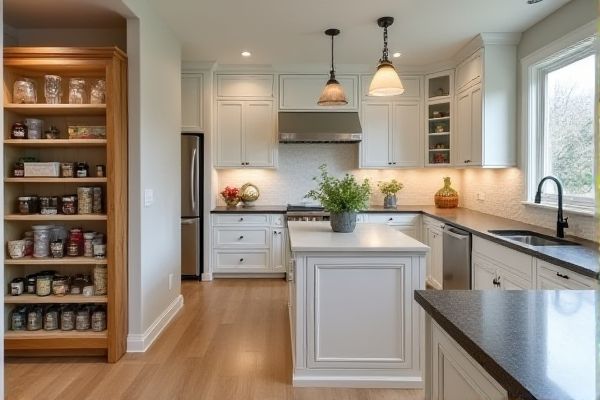
Choosing between a countertop pantry and a floor pantry depends on your kitchen space and storage needs, as countertop pantries offer accessibility and compactness while floor pantries provide larger capacity and organization options. Discover which pantry type best suits Your lifestyle and kitchen design by exploring the detailed comparison in the rest of this article.
Table of Comparison
| Feature | Countertop Pantry | Floor Pantry |
|---|---|---|
| Location | Placed on kitchen countertops | Installed or freestanding on the floor |
| Storage Capacity | Limited, suitable for small items and frequently used foods | Large capacity, stores bulk items and large containers |
| Accessibility | Easy reach during cooking | May require bending or reaching |
| Space Usage | Utilizes counter space, reducing workspace | Utilizes floor space, frees up counters |
| Installation | No installation required, portable | May require installation or structural changes |
| Cost | Generally lower cost | Higher cost due to size and installation |
| Ideal For | Small kitchens, limited storage needs | Large families, extensive food storage |
| Design Options | Compact, minimalistic designs | Varied designs including built-in and walk-in options |
Introduction to Countertop Pantries and Floor Pantries
Countertop pantries offer compact, easily accessible storage ideal for small kitchens or limited spaces, keeping frequently used items within arm's reach. Floor pantries provide larger, more spacious storage options that maximize vertical space and accommodate bulkier food items or kitchen supplies. Your choice depends on available space and organizational needs, with countertop pantries enhancing convenience and floor pantries delivering greater capacity.
Key Differences Between Countertop and Floor Pantries
Countertop pantries are compact storage units designed to sit on kitchen counters, ideal for small spaces and easy access to frequently used items, whereas floor pantries are larger, freestanding cabinets that provide extensive storage capacity for bulkier food supplies and kitchen essentials. Countertop pantries offer portability and convenience but limited space, while floor pantries optimize vertical storage and organization options with adjustable shelves. Material durability and design vary, with floor pantries often featuring sturdier construction suited for long-term use compared to the lighter, more portable design of countertop options.
Space Requirements: Countertop vs Floor Pantry
Countertop pantries require minimal space, making them ideal for small kitchens or apartments with limited square footage. Floor pantries demand significantly more room as they extend from the floor up, providing larger storage capacity but occupying substantial floor area. Choosing between the two depends on available kitchen space and storage needs, balancing compact convenience with extensive organization.
Storage Capacity Comparison
A floor pantry offers significantly greater storage capacity than a countertop pantry, accommodating bulkier items and larger quantities of groceries. Countertop pantries are compact and ideal for limited spaces, providing quick access to frequently used items but usually only handling small to medium-sized containers. Homeowners seeking extensive storage solutions typically favor floor pantries for their ability to organize a wide variety of food products and kitchen supplies efficiently.
Accessibility and Convenience
Countertop pantries offer easy access to frequently used items, keeping essentials within arm's reach and enhancing your kitchen's efficiency. Floor pantries provide larger storage capacity but may require bending or reaching down, which can impact convenience during busy cooking sessions. Choosing between the two depends on your kitchen layout and how quickly you want items accessible.
Aesthetics and Kitchen Design Impact
Countertop pantries offer a sleek, minimalist look that complements modern kitchen designs by keeping essentials within easy reach without cluttering the floor space. Floor pantries provide substantial storage and can be integrated as a focal point in traditional or farmhouse kitchens, enhancing the room's overall warmth and character. Your choice between these options directly influences the kitchen's visual flow and functional layout, balancing convenience with style.
Organization and Customization Options
Countertop pantries offer limited organization with compact storage, ideal for small kitchens but often lacking adjustable compartments. Floor pantries provide extensive customization options, featuring adjustable shelves, pull-out drawers, and various compartment sizes to accommodate diverse kitchen items. Enhanced flexibility in floor pantries supports better organization by allowing users to tailor storage solutions to specific needs.
Cost Analysis: Countertop vs Floor Pantry
Countertop pantries typically cost between $50 and $200, offering an affordable and space-saving storage solution for small kitchens. Floor pantries, on the other hand, range from $300 to over $1,000, depending on size, materials, and custom features, providing ample storage but requiring significant floor space. When budgeting, consider countertop pantries for low-cost convenience and floor pantries for higher capacity and long-term investment value.
Maintenance and Cleaning Considerations
Countertop pantries require frequent wiping to prevent crumbs and spills from accumulating due to their exposed nature, making daily maintenance essential for hygiene. Floor pantries often feature enclosed cabinets or doors that protect stored items from dust and pests, reducing the frequency of deep cleaning but possibly requiring occasional vacuuming or mopping underneath. Your choice should consider how easily you can access and clean surfaces to maintain a tidy kitchen environment.
Choosing the Right Pantry for Your Kitchen
Countertop pantries offer convenient, accessible storage ideal for small kitchens or frequent use items, maximizing countertop space without requiring floor area. Floor pantries provide larger capacity and better organization options, suited for kitchens needing substantial storage and less frequent access. Assess kitchen size, storage needs, and accessibility preferences to determine the optimal pantry type for efficient kitchen organization.
 homyna.com
homyna.com